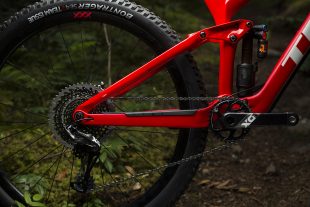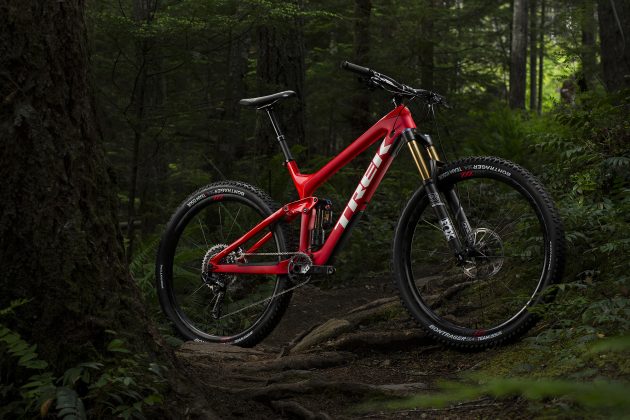Trek releases Slash 29, focused on enduro racing
Originally posted on July 18, 2016 at 20:15 pmThere was a general sense of “WTF” when Trek killed off the Remedy 29 for 2017. Yes the new Fuel EX 29 had the same geometry and a stiffer frame, but 130 mm of travel is still only 130 mm of travel. How is the semi-retired Tracey Mosely supposed to take on the EWS without her beloved Remedy 29?
As expected, Trek wasn’t really asleep at the wheel; it was busy developing a true race weapon for enduro riders: the Slash 29.
This thing is all about going as fast as possible on modern enduro race courses. With that in mind, it will only come in two models, both sharing a carbon fiber frame. That 150 mm travel frame gets all the typical technologies (except Full-Floater) in the Trek acronym soup: an OCLV Mountain Carbon main frame and 1x-specific stays, ABP, Boost 148, Knock Block steerer stop, EVO link, E2 tapered head tube, Mino Link, Control Freak internal routing, Carbon Armor, PF92, ISCG 05 and G2 Geometry. Drivetrains are 1x only, and forks are 160 mm on both the 9.8 and 9.9 RSL.
We didn’t get to ride this bike at the recent press camp, but we did get a sneak peek at a complete bike, maybe to help assuage the general consensus that the Remedy 29 would be missed.



Some things that stand out to me:
– Four frame sizes, including a 15.5″. While a lot of companies don’t make a small, long-travel 29er, Trek felt confident it could pull of a small frame that still rides well and can fit short riders just as well.
-No 27.5″ wheels or 27plus tires. This bike is about going as fast as possible, and in Trek’s collective mind that means 29″ wheels, a frame as stiff as a Session, and lots of suspension travel.
-No more Full-Floater. Much like the old DRCV valve, Full-Floater was developed when Trek determined there were shortcomings to rear shocks that it wanted to address. With modern metric shock packaging and improved internals, Trek determined that the ride characteristics is wanted could be accomplished without the floating shock mount, so that space was freed up for other uses.
-Geometry is extreme, but that is starting to seem normal. A 65.6/65.1-degree head angle is about as slack as you’ll find any stock 29er these days; the 1187 mm (46.7 inches, size medium) wheelbase is still a little less than a medium Session; and the 434 mm (17-inch) chainstays are pretty short for a 29er with 150 mm of travel. A bottom bracket that sits right around 13.5 inches is looking pretty stable to me.
-Hope you like red.
–The Pike on the 9.8 is a hell of a fork, but… Why not a Lyrik like the Remedy 9.9 RSL? Stiffer and stronger is a good thing Looks like I caught a misprint in the spec sheet, the 9.8 will have a Lyrik after all.
-I continue to be not stoked on internal routing. I am stoked on the Knock Block headset.
-This is a high-end race bike. If you don’t have a high-end bank account, you probably need to go look at aluminum Enduro 29s if you want a cheaper 29 enduro race bike. Pretty much everything else around 150 mm of travel is all carbon and $$$.
-The Bontrager SE5 is an excellent tire, it feels like a cross between a High Roller and a Minion, which makes me confused as to why this bike is spec’ed with the the SE4. Trek says the SE4 is a more versatile all-around tire, but c-mon, this is a race bike. Put the big meats on there.
Both bikes get SRAM drivetrains (X1 on the 9.8, XO1 Eagle 12 speed on the 9.9). A Pike Lyrik and Super Deluxe suspend the 9.8, the 9.9 has a Fox 36 and Float X2. Bontrager provides most everything else for the bikes, which isn’t a bad thing at all.
Pricing
| Slash 9.8 29 | $5,499.99 |
| Slash 9.9 29 RSL | $8,999.99 |
| Slash C F/S | $3,699.99 |
This bike aims squarely at the Specialized Enduro 29, Evil Wreckoning, and the new Niner RIP. While this isn’t a direct replacement for the Remedy 29, it really does look like a true enduro race bike, not an all-’rounder. We are seeing 29ers get more acceptance each year on the enduro circuit, but there still seems to be some resistance, even if the bigger wheels are faster. Sort of like why NBA players refuse to shoot foul shots granny-style, even though it is proven to be more accurate.
Bikes should be at dealers in October, so start saving. Trek’s website should be updated with more info soon.

Some FAQs from Trek:
What’s new with 2017 Slash?
With the new 2017 Remedy moving deeper into All-Mountain territory, new Slash sets its sights squarely on Enduro racing. With that in mind, we designed it around a carbon frame with the fastest-rolling wheel size. All 2017 Slash models use 29” wheels with Boost110 & Boost148 hub spacing. Rear travel moves to 150mm for the right balance of capability and efficiency. Both models get Enduro-minded 130mm/160mm forks which offer a better climbing position in the 130mm setting, and more confident descending in the 160mm setting.
Like the Fuel EX & Remedy, Slash gets a Straight Shot downtube with Knock Block frame defense for DH-worthy frame stiffness with no added weight. It also gets our extra-versatile Control Freak cable routing system to tie it all together.
How many Slash bike models are there?
Two. Both the Slash 9.8 and Slash 9.9 RSL share the same race-ready, full-carbon, 1x-specific frame.
What does Race Shop Limited mean?
Race Shop Limited, or RSL models are built with a parts spec that meets the demands of our top-level Enduro racers, including extra suspension adjustments, a Rapid Drive rear hub, and the new SRAM X01 Eagle 1×12 drivetrain.
Is Slash available as a frameset?
Yes. Slash is available as a frameset, which includes a Fox Factory Float X2 shock, Knock Block headset, and Line Pro 35mm stem.
What are the available sizes for Slash?
All Slash models are available in 15.5, 17.5, 19.5, and 21.5.
While most other long-travel 29ers suffer from design constraints that don’t allow for a Small frame size, Slash benefits from Trek’s decade of 29er experience, allowing us to offer a fast, great-handling 15.5” long-travel 29er.
Why doesn’t the new Slash use Full Floater?
We developed Full Floater years ago to address performance constraints associated with the air shocks that were available at that time. Since then, mountain bike shocks have evolved. More dynamic and responsive dampers, along with more refined air springs like EVOL and Debonair, offer the performance benefits our engineers sought to achieve with Full Floater.
Using a fixed lower shock mount opens up the lower frame area, giving us more opportunity to design stronger, stiffer frames and chainstays. This also gives us more flexibility to accommodate larger, more capable shocks. All of these effects are experienced most dramatically on long travel bikes, like the Slash.
Then why is Full Floater still on new Fuel EX and Remedy?
Full Floater works great on short to mid-travel bikes where engineering requirements are not so challenging. The demanding combination of design requirements – frame stiffness, bigger 29” wheel size, long travel, and fitting piggyback shocks– of the new Slash 29 presented the greatest opportunity to incorporate a new direction in suspension layout.
What front derailleurs work with the new frame?
None. The carbon chainstay is 1x only, which allowed our engineers to optimize stiffness and weight, as well as keep the length down to 435mm.
Is Slash compatible with other aftermarket shocks?
Yes. Slash uses new standard metric shock sizing (230×57.5mm).
Does Slash use a G2 fork?
Yes. It’s a 29er, and we know that our G2 Geometry with a 51mm offset fork still makes for the best 29er handling at any speed, on any terrain.
What Mino Link position is standard out of the box?
All MY17 full suspension bikes (EXCEPT Top Fuel and Session) will ship with the Mino Link in the High (steeper) setting. This gives Slash a headtube angle of 65.6 out of the box.
Is the new frame compatible with 27.5 Plus wheels and tires? 27.5?
No. We designed Slash around 29” wheels and tires for maximum speed. Running any other wheel/tire size will adversely affect handling and speed.
What is the max tire size for Slash frames?
29 x 2.6”
